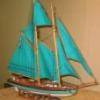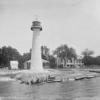MORE HANDBOOKS ARE ON THEIR WAY! We will let you know when they get here.
×
-
Posts
2,583 -
Joined
-
Last visited
Reputation Activity
-
 JSGerson got a reaction from goatfarmer11 in Rattlesnake by JSGerson - FINISHED - Mamoli - 1:64 - Using Robert Hunt’s practicum
JSGerson got a reaction from goatfarmer11 in Rattlesnake by JSGerson - FINISHED - Mamoli - 1:64 - Using Robert Hunt’s practicum
Because some of the gunports have lids and others don’t, a lip had to be constructed around the openings for those that did. Here is a picture from the practicum as I do not have a picture that depicts it.
-
 JSGerson got a reaction from CaptainSteve in Rattlesnake by JSGerson - FINISHED - Mamoli - 1:64 - Using Robert Hunt’s practicum
JSGerson got a reaction from CaptainSteve in Rattlesnake by JSGerson - FINISHED - Mamoli - 1:64 - Using Robert Hunt’s practicum
The lettered nameplate in turn was then glued in place. I knew that ships of that era did that because the actual USS Constitution is done the same way. I chose Holly, a light colored wood, to add some contrast.
-
 JSGerson got a reaction from CiscoH in Rattlesnake by JSGerson - FINISHED - Mamoli - 1:64 - Using Robert Hunt’s practicum
JSGerson got a reaction from CiscoH in Rattlesnake by JSGerson - FINISHED - Mamoli - 1:64 - Using Robert Hunt’s practicum
The idea was to make a router-like set-up without using a router bit. As shown in the diagrams below, if I set up the piece to be cut directly on the drill table, the bit doesn’t bite into the wood. The shaft blocks the bit from touching the wood. However, if the work surface is tilted then the bit can cut the wood. Additionally, by moving the work surface left or right using the x-y table, the bit can be adjusted up and down relative to the work surface due to the wedge. The wood is then ”routed” by hand. With a little experimenting and practice it seemed to work.
NOTE: I have a new pocket camera (Cannon SX160 IS) with a terrific built-in macro capability. Now I can show you my screw ups in excruciating detail!
-
 JSGerson got a reaction from sport29652 in Rattlesnake by JSGerson - FINISHED - Mamoli - 1:64 - Using Robert Hunt’s practicum
JSGerson got a reaction from sport29652 in Rattlesnake by JSGerson - FINISHED - Mamoli - 1:64 - Using Robert Hunt’s practicum
It's easy when you're a life long bachelor, forced into retirement (I got laid off just as I turned 66. I had planned to work till I was 67), no commitments, no dependents ( if you don't count the cat), and all the time in the world to do what ever. Actually I only put in a few hours a day, sometimes none, and others I just contemplating the sequence of actions needed to perform a particular task with no actual physical work done. Some might call that day dreaming!
I've accomplished more in the last 12 months due to the "retirement" than I did in the four years prior. Yeah, I've been at it about 5 years. Looking at what needs to be accomplished for the masts, yards, and rigging I'm guessing another 2 years and that no including finishing the hull. At the rate I'm going, I figure I've got one more boat in me to complete and that's the Conny. After that I'll probably be half blind, feeble, no patience, and yelling at kids "get off the lawn."
-
 JSGerson got a reaction from maso in Rattlesnake by JSGerson - FINISHED - Mamoli - 1:64 - Using Robert Hunt’s practicum
JSGerson got a reaction from maso in Rattlesnake by JSGerson - FINISHED - Mamoli - 1:64 - Using Robert Hunt’s practicum
The idea was to make a router-like set-up without using a router bit. As shown in the diagrams below, if I set up the piece to be cut directly on the drill table, the bit doesn’t bite into the wood. The shaft blocks the bit from touching the wood. However, if the work surface is tilted then the bit can cut the wood. Additionally, by moving the work surface left or right using the x-y table, the bit can be adjusted up and down relative to the work surface due to the wedge. The wood is then ”routed” by hand. With a little experimenting and practice it seemed to work.
NOTE: I have a new pocket camera (Cannon SX160 IS) with a terrific built-in macro capability. Now I can show you my screw ups in excruciating detail!
-
 JSGerson got a reaction from WackoWolf in Rattlesnake by JSGerson - FINISHED - Mamoli - 1:64 - Using Robert Hunt’s practicum
JSGerson got a reaction from WackoWolf in Rattlesnake by JSGerson - FINISHED - Mamoli - 1:64 - Using Robert Hunt’s practicum
The idea was to make a router-like set-up without using a router bit. As shown in the diagrams below, if I set up the piece to be cut directly on the drill table, the bit doesn’t bite into the wood. The shaft blocks the bit from touching the wood. However, if the work surface is tilted then the bit can cut the wood. Additionally, by moving the work surface left or right using the x-y table, the bit can be adjusted up and down relative to the work surface due to the wedge. The wood is then ”routed” by hand. With a little experimenting and practice it seemed to work.
NOTE: I have a new pocket camera (Cannon SX160 IS) with a terrific built-in macro capability. Now I can show you my screw ups in excruciating detail!
-
 JSGerson got a reaction from Kenneth Powell in Rattlesnake by JSGerson - FINISHED - Mamoli - 1:64 - Using Robert Hunt’s practicum
JSGerson got a reaction from Kenneth Powell in Rattlesnake by JSGerson - FINISHED - Mamoli - 1:64 - Using Robert Hunt’s practicum
Found a few more. Sorry there not in order. I hope these help.
And thank you Pasi Ahopelto
-
 JSGerson got a reaction from Senior ole salt in Rattlesnake by JSGerson - FINISHED - Mamoli - 1:64 - Using Robert Hunt’s practicum
JSGerson got a reaction from Senior ole salt in Rattlesnake by JSGerson - FINISHED - Mamoli - 1:64 - Using Robert Hunt’s practicum
Then there is the matter of gun port lid tackle used to open and close the lid.
The Practicum and Hahn’s drawings are silent in this regard. The Mamoli plan’s show a continuous rope from the inner hull through a hole just above the gunport and below the channels through a hole low in the lid which then hangs down inside the hull. I must assume there were knots or some other method by which the rope was secured to the lid on the actual ship. These would be too small to see at this scale. The Model Shipway plans (which I just got my hands on) show a ring on the outside of the gunport lid from which the rope is attached and then goes over the channels into the hull. Going over the channel doesn’t make sense as the rope would then be passing through the hull and appearing on the deck above. Nothing is shown as to how the lid was closed. Any ring that I could buy or fabricate would appear to my eyes too large for the scale of the model.
Based on the above, I have elected to follow the Mamoli plans. The method of securing the rope to the lid is moot as far as I am concerned due to the scale. In actuality, beige thread was glued to a hole on the outside hull above the gunport and below the channel, passed through a hole in the lid at the lower end and glued to the inside hull as if it were secured by a cleat which the observer can’t see. To accomplish this, the thread was first glued to the outside hull above the gunport. Once set, it was threaded through the hole in the lid. The model was laid on its side and the lid was CA glued in place so it stood vertical. It was almost like balancing a pencil on its end. It was left this way for at least 30 minutes. I was taking no chances. This was done nine more times. This took a lot longer than I had expected. The result is shown below.
-
 JSGerson got a reaction from Jaxboat in USS Constitution by BRiddoch - Model Shipways - Scale 1:76
JSGerson got a reaction from Jaxboat in USS Constitution by BRiddoch - Model Shipways - Scale 1:76
I asked my nephew this question about the copper tape. He works for a company in Japan (he speaks very fluent Japanese) that deals with adhesives and coatings, matching buyers with sellers of these various products. In other words they match the problem with a solution. He does all their technical translations into English as well as maintain their website. He is NOT a model builder however. He responded:
Good question. I've actually never come across copper tape before, but I'll look into it. It's something we don't cover specifically, and if I haven't come across it, that probably means we've never covered it. That said, I can tell you all kinds of things you never knew (or wanted to know) about copper tape. You are correct in assuming that no tape lasts forever. Under specific conditions (mostly sealed conditions) it can last years, even decades. They use all sorts of tapes in construction now, but that is usually for temporarily holding things together until something more permanent is used (screws, etc.). But in a sealed environment, such as that inside an aluminum window frame, it will last as long as your house is standing. In fact, those tapes are often used for waterproofing and not as a structural element, so must be virtually immune to water and moisture. But the big problem with adhesive tapes is two fold. The first is that most are pressure-sensitive, which means they don't even try to be permanent. The second is that it really depends on what you are taping (the adherent). I am assuming you will be working with wood, and very porous wood at that. This means that oxygen will reach the adhesive layer relatively easily, and quickly. This will oxidize the adhesive (not to mention the copper itself), and cause it to become gooey or dry out, depending on the adhesive agent. The difficulty is in finding a copper tape that uses the right adhesive agent for the adherent. Most stick to wood pretty well because wood is rough, but before applying the tape, make sure there is as little dust as possible. This will increase the life of the tape. You could also put a transparent sealant over the tape to increase it's life. I assume you would add a sealant to the ship anyway, so you would want to do this after applying the tape (granted, the solvent in the sealant could dissolve the adhesive, just as the solvent in the adhesive could dissolve the paint it is on and cause delamination). In the Tiffany lamps, the solder is basically used to seal the tape so that oxygen does not reach the adhesive agent. Copper tape is used because copper is heat resistant and conductive and can thus withstand the soldering temperature and bond well with the solder itself. I doubt you could solder copper tape on a wood surface, though. Not that you would want to anyway for the application you are considering. From my understanding of how adhesive tape works and knowing that you would not be working in a nice environmentally controlled area with pressure gradients to whisk away dust as you worked, I would find an alternative. Tape is what is usually called a PSA (pressure sensitive adhesive) and is thus always in a moist state. So I would use a true adhesive that dries completely and copper foil strips. I know that would be more difficult, but if you want it to last years, or decades, to me that seems like the better option. I'll see if I can find anything on existing tapes in terms of durability, but I have a feeling that copper tape is not designed to be applied to wood or organic surfaces (paint, etc), so I would recommend against it. I don't know if I have opened a can of worms, muddied the waters, and befuddled everyone. Let's see if he can come up with a more definitive answer.I would hate to have to glue individual strips with CA glue to get long lasting results. -
 JSGerson got a reaction from Torrens in Rattlesnake by JSGerson - FINISHED - Mamoli - 1:64 - Using Robert Hunt’s practicum
JSGerson got a reaction from Torrens in Rattlesnake by JSGerson - FINISHED - Mamoli - 1:64 - Using Robert Hunt’s practicum
Forecastle Deck Planking – Final
One last time (I think) I broke out the draw plate and drew the bamboo strips (formerly bamboo food skewers) through the holes till they got through the #29 orifice. Cutting the fine dowels into short pieces resulted in treenails that fitted the hole the #69 drill made very nicely. The holes were drilled like before on the quarterdeck where the planking crossed the deck beams and the tree nails inserted. Using the Poly-wipe as my adhesive, a tiny drop was applied with a toothpick at each hole. There was no worry if I got sloppy as the whole deck would eventually be coated with it. Once I felt the treenails had been secured after a couple of hours of drying, the excess bamboo was snipped off and sanded down flush. The whole deck was then sanded. The deck was applied with poly-wipe, sanded, and applied again.
-
 JSGerson got a reaction from Torrens in Rattlesnake by JSGerson - FINISHED - Mamoli - 1:64 - Using Robert Hunt’s practicum
JSGerson got a reaction from Torrens in Rattlesnake by JSGerson - FINISHED - Mamoli - 1:64 - Using Robert Hunt’s practicum
Forecastle Deck Planking – initial
With the catheads installed, it was time to start the forecastle deck planking. Just like the quarterdeck, 1/32” x 3/32” holly was used. Starting from the center the first plank was set in place. The practicum would have me lay out all the planks and later on drill out the foremast hole. I elected to create the foremast hole earlier. As soon as I had glued down the second plank, a notch mas make in the center plank to indicate where the foremast was to pass through the deck. By the time I had five planks down, I commenced to complete the hole. I wanted the five planks glued in solid so that when the hole was expanded to fit the dowel that would become the mast, there would be enough strength to resist drilling and filing. The mast has a rake to it and the deck hole butts right up to the support beam below so everything had to line up perfectly.
-
 JSGerson got a reaction from goatfarmer11 in Rattlesnake by JSGerson - FINISHED - Mamoli - 1:64 - Using Robert Hunt’s practicum
JSGerson got a reaction from goatfarmer11 in Rattlesnake by JSGerson - FINISHED - Mamoli - 1:64 - Using Robert Hunt’s practicum
For all intents and purposes, the Quarterdeck is complete...at least for now.
-
 JSGerson got a reaction from Torrens in Rattlesnake by JSGerson - FINISHED - Mamoli - 1:64 - Using Robert Hunt’s practicum
JSGerson got a reaction from Torrens in Rattlesnake by JSGerson - FINISHED - Mamoli - 1:64 - Using Robert Hunt’s practicum
Fore Brace Bitts
The fore brace bit in contrast to the binnacle is quite simple – three piece of wood notched and glued together.
-
 JSGerson got a reaction from Torrens in Rattlesnake by JSGerson - FINISHED - Mamoli - 1:64 - Using Robert Hunt’s practicum
JSGerson got a reaction from Torrens in Rattlesnake by JSGerson - FINISHED - Mamoli - 1:64 - Using Robert Hunt’s practicum
Initial Quarterdeck Planking
If the Quarterdeck were to be fully planked, there would have been no reason to do a lot of the previous work because no one would have been able to see it. Therefore the Quarter and Fore Decks are partial planked.
The planking starts in the center and works its way out as well as fore to stern. The planking is the same as the lower deck with charcoal to simulate caulking and bamboo for tree nails.
-
 JSGerson got a reaction from Torrens in Rattlesnake by JSGerson - FINISHED - Mamoli - 1:64 - Using Robert Hunt’s practicum
JSGerson got a reaction from Torrens in Rattlesnake by JSGerson - FINISHED - Mamoli - 1:64 - Using Robert Hunt’s practicum
Because I didn’t think that back in the late 1700’s they would have used a slab of wood that large, I scribed the pieces with an X-acto blade and a pencil to make it look like planking. The each piece had a large half circle cut out of it the same diameter as the capstan with whelps instead of the capstan post. The two pieces then were wrapped around the capstan and glued into place.
-
 JSGerson got a reaction from Torrens in Rattlesnake by JSGerson - FINISHED - Mamoli - 1:64 - Using Robert Hunt’s practicum
JSGerson got a reaction from Torrens in Rattlesnake by JSGerson - FINISHED - Mamoli - 1:64 - Using Robert Hunt’s practicum
The hardware that goes on the pumps is made from very thin styrene plastic painted black. Normally I would have chosen black paper for scale, but because the vertical post that holds the pump rocker arm is a real supporting member, paper wouldn’t work. The band that goes around top is .10” x .04” styrene. The post is made of .015” x .06” styrene and it has a U-shape notch at the top to support the rocker arm. The pump shaft is wire which fits into a hole in the rocker arm. Because the pump cylinder was completely hollowed out, a plug was fashion out of some scrap wood and hole was drilled into it for the pump shaft to fit. This was fitted into the bottom of the octagon cylinder. The spouts are made 3/64” rod styrene plastic. The last item was the rocker arm handles. The Practicum called for this to be fabricated out of wire painted black. I choose to make it look like wood and used bamboo again made using a draw plate. Once everything was painted and assembled, it was installed on the model.
-
 JSGerson got a reaction from Torrens in Rattlesnake by JSGerson - FINISHED - Mamoli - 1:64 - Using Robert Hunt’s practicum
JSGerson got a reaction from Torrens in Rattlesnake by JSGerson - FINISHED - Mamoli - 1:64 - Using Robert Hunt’s practicum
After an ungodly amount of time, all twenty cannons were on board.
-
 JSGerson got a reaction from Duanelaker in Rattlesnake by JSGerson - FINISHED - Mamoli - 1:64 - Using Robert Hunt’s practicum
JSGerson got a reaction from Duanelaker in Rattlesnake by JSGerson - FINISHED - Mamoli - 1:64 - Using Robert Hunt’s practicum
The stern and counter carvings were installed to the model
-
 JSGerson got a reaction from Torrens in Rattlesnake by JSGerson - FINISHED - Mamoli - 1:64 - Using Robert Hunt’s practicum
JSGerson got a reaction from Torrens in Rattlesnake by JSGerson - FINISHED - Mamoli - 1:64 - Using Robert Hunt’s practicum
The Counter Carvings
Mr. Hunt wanted to provide an alternative method of creating ornamentation using a clay product called Premo because these counter carvings use compound curves and are difficult to create in wood even for him. I didn't like the results he got with Premo as shown in the Practicum, so I chose the hard method – I would wood carve it.
I made numerous attempts because there is no true view of this shape. Through trial and error and shear tenacity I final came up with the shape that appears to work and would fit to the model.
-
 JSGerson got a reaction from Torrens in Rattlesnake by JSGerson - FINISHED - Mamoli - 1:64 - Using Robert Hunt’s practicum
JSGerson got a reaction from Torrens in Rattlesnake by JSGerson - FINISHED - Mamoli - 1:64 - Using Robert Hunt’s practicum
CHAPTER 6 –The Carvings
Transom and Side Stern Windows
At this point the Practicum directs the builder to start the carvings. I looked at the boat and wondered why aren’t the transom and side stern windows being installed at this point? It would seem to be easier now than later when the carvings and interior stuff get installed. So once more I deviated from the Practicum.
Looking at the transom, Mr. Hunt elected not to put in the center panel. All the models I saw including Mr. Hahn’s had the panel, so I decided that I would install the panel. It would have been easier when the window opening were first constructed, but now was not too late. Following the existing window lines the panel opening was drawn, drilled, cut out, and trimmed. Not knowing how the panel was constructed or how that construction would affect the completion of the interior as directed by the Practicum, I decided to use the 1/64” plywood for the panel face because it was so thin. I figured it wouldn’t affect the Practicum’s building process. Later on I saw one model maker use planks.
Looking at the Hahn model pictures, I saw that the windows and the panel had frames around their openings. The windows then had their own frames. The opening frames were constructed directly on the model. The panel plywood was cut to size to just cover the opening and glued to the interior.
-
 JSGerson got a reaction from Torrens in Rattlesnake by JSGerson - FINISHED - Mamoli - 1:64 - Using Robert Hunt’s practicum
JSGerson got a reaction from Torrens in Rattlesnake by JSGerson - FINISHED - Mamoli - 1:64 - Using Robert Hunt’s practicum
Once they sanded, poly-wiped, they didn’t look too bad. They were installed in their respective positions on the model.
End Chapter 5
-
 JSGerson got a reaction from Torrens in Rattlesnake by JSGerson - FINISHED - Mamoli - 1:64 - Using Robert Hunt’s practicum
JSGerson got a reaction from Torrens in Rattlesnake by JSGerson - FINISHED - Mamoli - 1:64 - Using Robert Hunt’s practicum
CAUTION
The top cutaway notch must be checked to ensure that it matches where the deck beams will go using a 3/16” wide piece of wood as shown below from the Practicum.
-
 JSGerson got a reaction from goatfarmer11 in Rattlesnake by JSGerson - FINISHED - Mamoli - 1:64 - Using Robert Hunt’s practicum
JSGerson got a reaction from goatfarmer11 in Rattlesnake by JSGerson - FINISHED - Mamoli - 1:64 - Using Robert Hunt’s practicum
The door hinges were made from black paper and the doorknobs are the heads of some bass nails I had lying around.
-
 JSGerson got a reaction from Duanelaker in Rattlesnake by JSGerson - FINISHED - Mamoli - 1:64 - Using Robert Hunt’s practicum
JSGerson got a reaction from Duanelaker in Rattlesnake by JSGerson - FINISHED - Mamoli - 1:64 - Using Robert Hunt’s practicum
I had some very thin clear plastic film packaging material I received from thing I ordered mail order – perfect for windows. The problem was I didn't know what kind of plastic it was which meant I didn't know what kind of glue to use. The “wood” I was using for the window frames was bamboo, the same stuff I had been using for the tree nails. I use it because I knew from the tree nails, I could make the pieces very thin and straight with little problem and it would hold up. I tried super glue and Weldbond which stuck to the bamboo but not the plastic. Because I couldn't create the frame, I couldn't lift it up to insert into door window opening. It was time for Plan B.
The windows are constructed like a sandwich: six pane frame – one large window pane – six pane frame. I created the window frames directly in the opening. That meant constructing the first perimeter frame and the interior frames gluing the wood frame to the wood door. Then I fitted a single piece of clear plastic that covered the whole opening. Finally I constructed the second frame assembly on the other side of clear plastic effectively securing the plastic in place. I wanted to have the interior frames all flush but had too much trouble with the horizontal frame member. The pieces were simply too small to handle, so I just laid the horizontal piece on top of the verticals. Unless one looks at those windows with a boroscope, you can’t tell.
-
 JSGerson got a reaction from goatfarmer11 in Rattlesnake by JSGerson - FINISHED - Mamoli - 1:64 - Using Robert Hunt’s practicum
JSGerson got a reaction from goatfarmer11 in Rattlesnake by JSGerson - FINISHED - Mamoli - 1:64 - Using Robert Hunt’s practicum
As anyone can see, this planking job leaves a bit to be desired, but there it is. If I were to do it again hopefully it would be better.
Tree Nails
The tree nails are lined up along the bulkheads, two treenails per width of the plank. At the butt joints the tree nails are staggered.
End of Chapter 4












